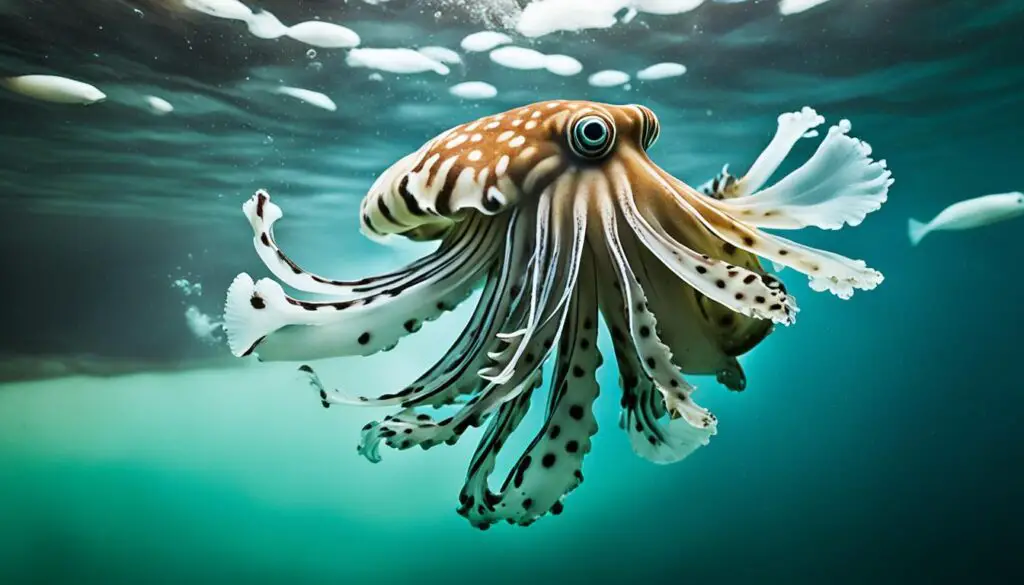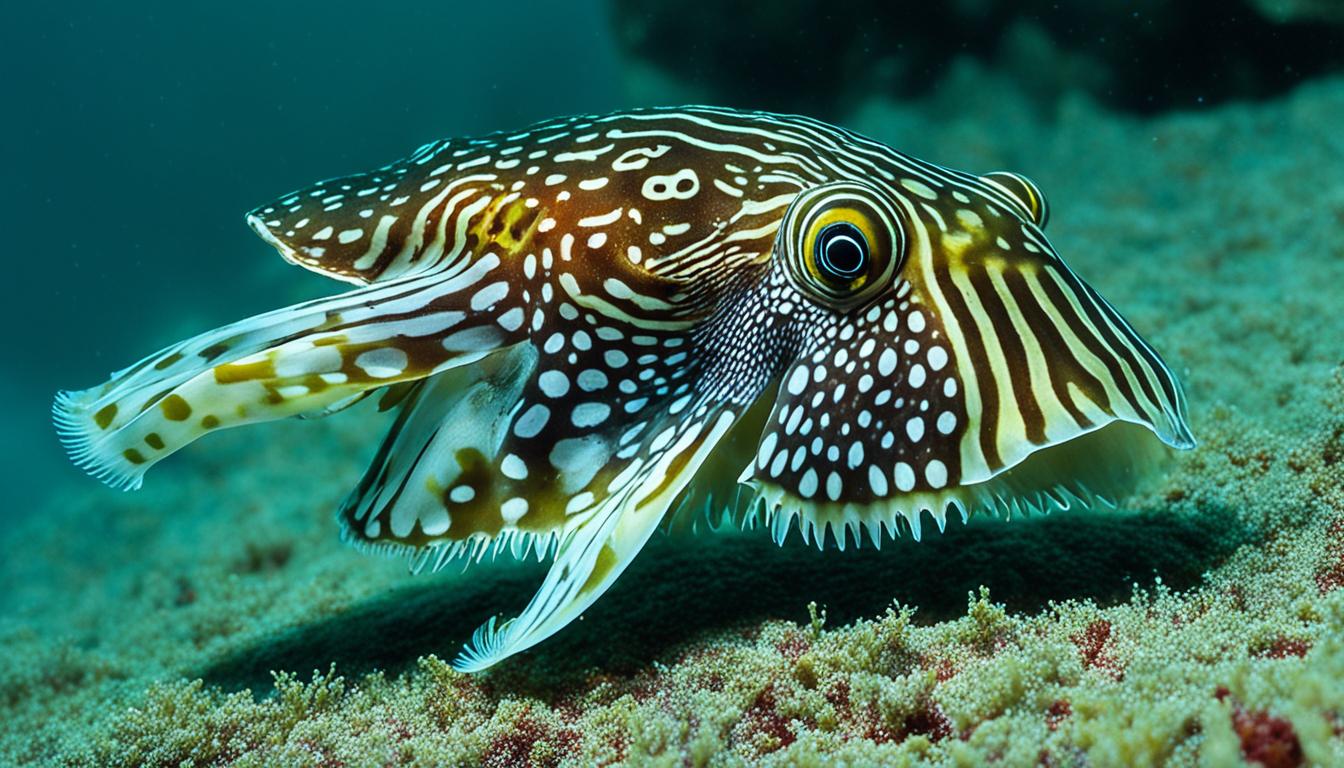The cuttlefish is a remarkable invertebrate known for its complex defense mechanisms. You might wonder how these fascinating creatures protect themselves from predators. They use a variety of strategies that show off their advanced cognitive abilities and sensory functions.
They can adapt their behavior and appearance quickly when faced with threats. This ability to change is a key part of their survival instincts. From stunning camouflage to ink ejection, let’s explore the remarkable ways cuttlefish defend themselves.
Understanding Cuttlefish Defense Mechanisms
Cuttlefish have amazing ways to stay safe in the ocean. They have a big brain compared to their body size, which helps them make quick decisions. This is key for avoiding predators.
They also have special features that help them survive. For example, the cuttlebone helps them control their buoyancy. This lets them move easily through different depths. They can also change their skin color and texture quickly. This makes it hard for predators to see them.
Learning about these ways shows how adaptable cuttlefish are when facing threats. Their smartness and physical skills make them interesting to study. They help us understand the complex life in the ocean.
| Defense Mechanism | Description | Benefit |
|---|---|---|
| Buoyancy control | Utilization of cuttlebone | Allows for movement through water columns |
| Camouflage | Change in color and texture | Makes them less visible to predators |
| Intelligence | High brain-to-body ratio | Enhances decision-making in threat scenarios |
How do cuttlefish defend themselves?
Cuttlefish have amazing ways to protect themselves. They use special tactics like changing color and texture to blend in. This helps them survive in the ocean.
Cuttlefish Camouflage Tactics
Cuttlefish are masters of disguise. They have cells called chromatophores that let them change color fast. By changing these cells, they look like rocks or coral reefs.
This trick helps them hide from predators and sneak up on prey. It’s a clever way to stay safe and hunt effectively.
Color Change and Texture Adaptation
Cuttlefish also change their skin color and texture to blend in. They can make their skin smooth or rough to match their surroundings. This is done by controlling different skin layers.
This skill lets them disappear in the water. They become almost invisible, making them one of nature’s best at hiding.
Cuttlefish Ink Defense
Cuttlefish have amazing ways to defend themselves, with their ink being a key part. When they see danger, they can squirt ink from a special sac. This ink makes a thick cloud, helping the cuttlefish get away without being seen.
The ink does more than just hide the cuttlefish. It can make shapes that look like the cuttlefish itself. This trick confuses predators, giving the cuttlefish time to escape. This shows how smart and adaptable these creatures are when facing danger.
This clever defense method of the cuttlefish confuses predators. The ink makes it hard to see and smell, adding a layer of protection. This helps the cuttlefish survive by making it hard for predators to track them.
| Feature | Description |
|---|---|
| Ink Composition | A mixture of melanin and mucous that creates a thick cloud. |
| Release Mechanism | Triggered by stress or perceived threats through muscular contraction of the ink sac. |
| Pseudomorphs | Ink can take shapes that mimic the cuttlefish’s silhouette, acting as a decoy. |
| Effect on Predators | Disrupts visibility and sensory cues, delaying predator response. |
Cuttlefish Predator Evasion Strategies
Cuttlefish have amazing ways to avoid predators, showing how smart and adaptable they are in the ocean. They use jet propulsion to quickly get away from danger. This lets them move fast and avoid threats.
Flight and Jet Propulsion
When danger comes close, cuttlefish can move fast to get away. This is thanks to their special mantle cavity. It lets them push water out to speed up. This makes them go really fast, often leaving threats behind quickly.
Their speed is key to avoiding predators, giving them an edge. Their bodies are also shaped to help them dodge capture. This shows how clever and instinctively smart cuttlefish are in the wild.
Cuttlefish Mimicry and Bluffing Behavior
Cuttlefish have a special way to defend themselves using mimicry and bluffing. These tactics help them survive when faced with predators. They make themselves look bigger and more threatening to scare off threats.
Deimatic Displays for Intimidation
Cuttlefish can change how they look to seem bigger and more intimidating. They show dark eye spots and spread out their arms. This can make smaller predators run away, keeping the cuttlefish safe.
Behavioral Adaptations to Predators
For bigger threats, cuttlefish change their color and move away quickly. They judge how big a threat is before acting. These actions help them avoid being caught by predators. Cuttlefish are very good at surviving in the ocean because of these skills.
| Behavior | Purpose | Effectiveness |
|---|---|---|
| Deimatic Displays | Intimidate small predators | High |
| Color Darkening | Blend into surroundings | Very High |
| Behavioral Adaptations | Avoid larger predators | Moderate to High |
Cuttlefish Counterattack Tactics
Cuttlefish are known for their amazing defense skills. They can also counterattack when needed. When predators get too close, these smart creatures use various tactics.
With a sharp beak, cuttlefish can bite hard to keep away larger threats. This shows how adaptable they are in fights. If they can’t escape, they use aggressive actions to stop attackers.
Cuttlefish have a wide range of behaviors to help them survive. They often use both dodging and fighting to protect themselves. This shows they prefer to avoid fights but will defend themselves when necessary.

| Defense Mechanism | Description | Effectiveness |
|---|---|---|
| Beak Biting | Using sharp beak to inflict damage on predators. | High |
| Color Change | Rapidly changing color to confuse or intimidate. | Medium |
| Defensive Posturing | Displaying an aggressive stance to appear larger. | Medium |
| Jet Propulsion | Using jet propulsion to evade or reposition quickly. | High |
These tactics show how adaptable cuttlefish are when facing danger. They play a key role in the ocean’s balance.
Conclusion
Cuttlefish have amazing ways to defend themselves in the ocean. They can change color to blend in or release ink to escape quickly. These skills show how well they can protect themselves and adapt to their surroundings.
They also use tricks like mimicry and bluffing to stay safe. By changing color and texture, they can trick predators. This shows how smart and resourceful cuttlefish are.
Learning about cuttlefish teaches us about the complex life in the ocean. It shows how marine animals use different strategies to survive. As we learn more about these creatures, we see the value of protecting our oceans for the future.










